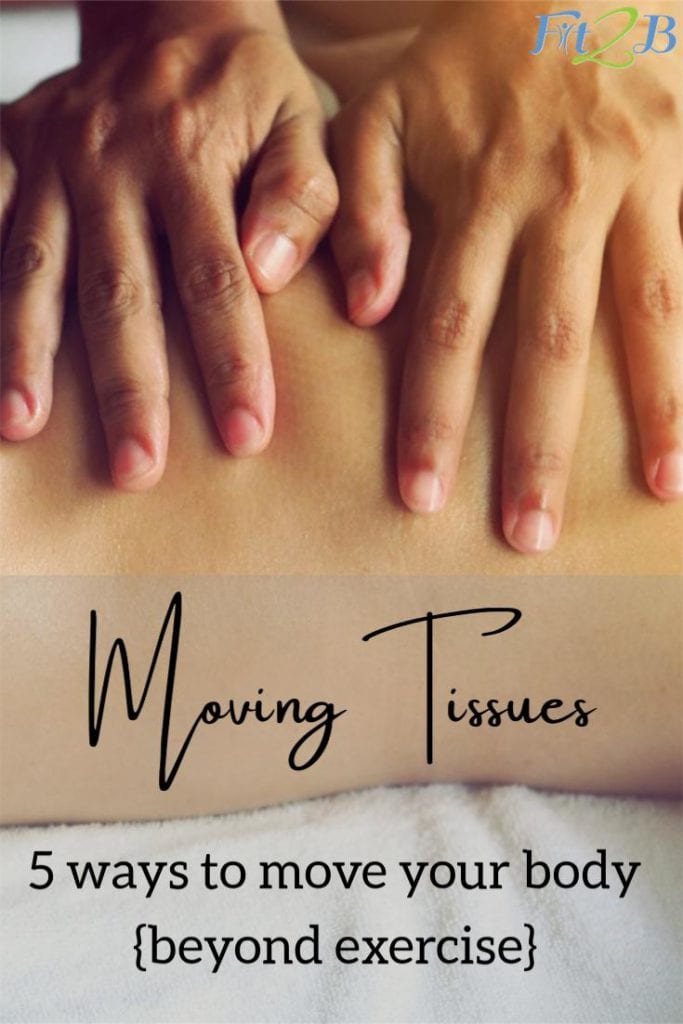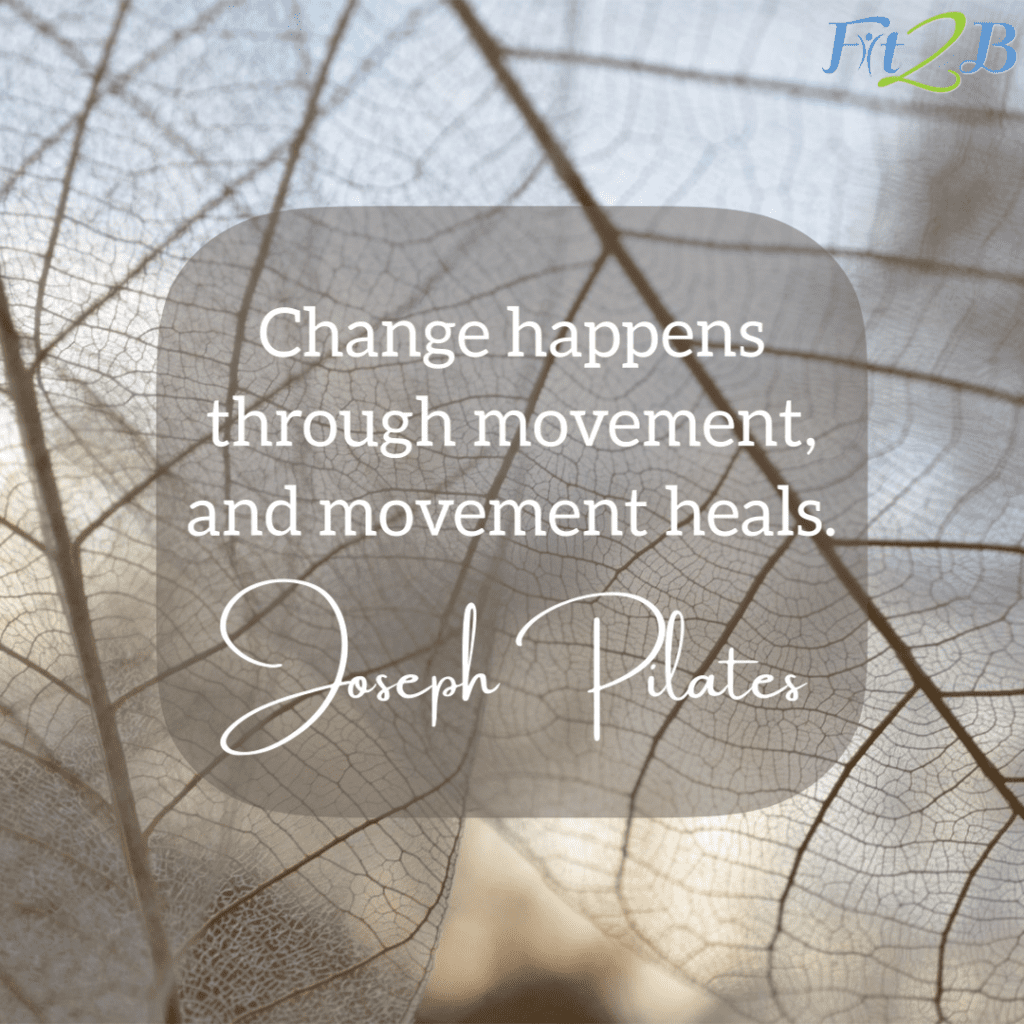Blog, Fit2B Magazine
Ways to Move Your Tissues beyond Exercise
What if “working out” isn’t the only way to exercise, move your tissues, and strengthen your body? Moving tissues beyond exercise is easier than you think! When we go beyond thinking of movement as exercise that repetitively shifts one or several parts of our body from one spot to another and we start to look for other ways to stimulate our tissues with the goal of improving circulation, building resilience, and facilitating regeneration, we find more opportunities to both move AND exercise. Watch this short video (in which my hair is fiery bright because I was filming the ORANGE workouts in our color series that day) for my expressive thoughts on ways to move our tissues beyond exercise.
We can move our bodies on purpose, and our bodies can also be moved by others and by our environment. My dog can jump on me and knock me over. My chair is shaping my buns right now. The light coming through my window woke me up and prompted me to open my eyes this morning. The colder weather is motivating me to haul wood for my fireplace. I slept weird last night on a new pillow, and I woke up with a stiff neck, so I will ask my husband to rub it later.
My dog forced all my tissues to move and absorb impact. My chair isn’t comfortable, so I change positions a lot (this is a good thing). Daylight moved my eyelids from closed to open, helping my circadian rhythm, which gives me energy for further motion. Chilly air makes me shiver and chop wood. The pillow put me in a slightly different position which forced my neck into a position it didn’t like. Exercise isn’t the only thing moving us. Lots of stuff is moving us (moving our tissues) all the time.
Here are 5 ways to move your tissues beyond exercise:
Yeah, so — unlike an animal suddenly jumping on you unexpectedly, you can choose to engage in or facilitate the following things.
Massage — Whether you rub a sore muscle yourself, or someone else is allowed to press out the bellies of your muscles for you, massaging is an excellent way to move your body. As the tissues on the outside of your body are rubbed, they tug and pull on the fascial layers below your skin. Everything is connected.
Rearrange Your House — You move in set patterns. You get up and move your tissues along certain paths. You navigate the same way each day around your furniture. You reach for the same dishes with the same motions. You sit in the same chairs at the same heights with your legs crossed a certain way. If you move your bed or chairs around, or get a different chair that’s lower to the ground, or cut a bit of the legs of your chair off, or ditch chairs altogether, imagine all the new ranges of motion you’d be exploring without having to think much … at least after the first few days while you’re getting used to it.
Go Hiking — While this is definitely considered exercise in my book, a hike on an unpaved trail offers a massive variety of movement for all of your tissues. Uneven terrain with a few rocks and stumps that force you to maneuver and balance are amazing for your whole system! Ever noticed how you intuitively spread your arms out? Reach to grab a tree limb? Hitch a leg really high to get over a downed tree? Sit deeply on the ground while resting? Hiking is great for your psoas, too!
More Floor Time — It takes more muscular action and thus more energy to get yourself down onto the floor and back up again than to get yourself in and out of a chair. While you’re on the floor, you tend to change positions a lot, too! It takes more work to shift around and hold yourself up! Bonus: The better you are at getting up and down off the floor, the longer you maintain your independence and avoid early death. Why not watch shows and read books on the floor sometimes?
“If a middle-aged or older man or woman can sit on and rise from the floor using just one hand — or even better without the help of a hand — they are not only in the higher quartile of musculoskeletal fitness but their survival prognosis is probably better than that of those unable to do so,” said researcher Claudio Gil Araújo of Gama Filho University, in Rio de Janeiro, whose study of 2,000 men and women over age 50 was published in the European Journal of Cardiovascular Prevention on Dec. 13, 2012.
Physical interactions – Last but not least on my list of 5 ways to move your tissues beyond exercise is encouraging you to seek out more consensual physical contact. May I have a hug? Want to arm wrestle? Hey kids, who’s up for a pillow fight? May I have the honor of this dance? Hey, baby … you wanna …?
How do you move beyond exercise?
Leave us a comment below! What are some ways you deliberately move your tissues beyond traditional exercise and workouts? After reading this “vlog” — a.k.a. “video blog” — are you looking around your house and noticing how it positions you? What could you add to (or take away from) your environment to move yourself more?
Learn how to access Fit2B workouts Today!



I can’t think on this topic without a dozen Katy Bowman articles and book chapters echoing in my head! I try to do a figure four stretch while I sit in my kitchen chairs. I move around while I home school my kids (math at the table, reading lessons on the floor by our couch, handwriting at their lap desks on the floor) and sometimes I challenge my kindergarten boy to 20 pushups if he’s really dragging between subjects (he always thinks he wins!) I’ve tried to carry my babies in my arms more on walks. I try to breastfeed longer than a year if possible because of how that movement affects their teeth and jaw formation. I am working to grow a little more of our own food with each new garden year. So many mindset and movement shifts over the last few years of learning about this, and if you add one little change at a time it is freeing, but doesn’t have to be overwhelming.
I love this mentality! One of my goals for 2019 was to be more mindful of my body, especially at my desk job. I have been using a stability ball instead of a regular chair sometimes and it was been so much better for my posture. Thank you for providing a sane voice in the fitness world.